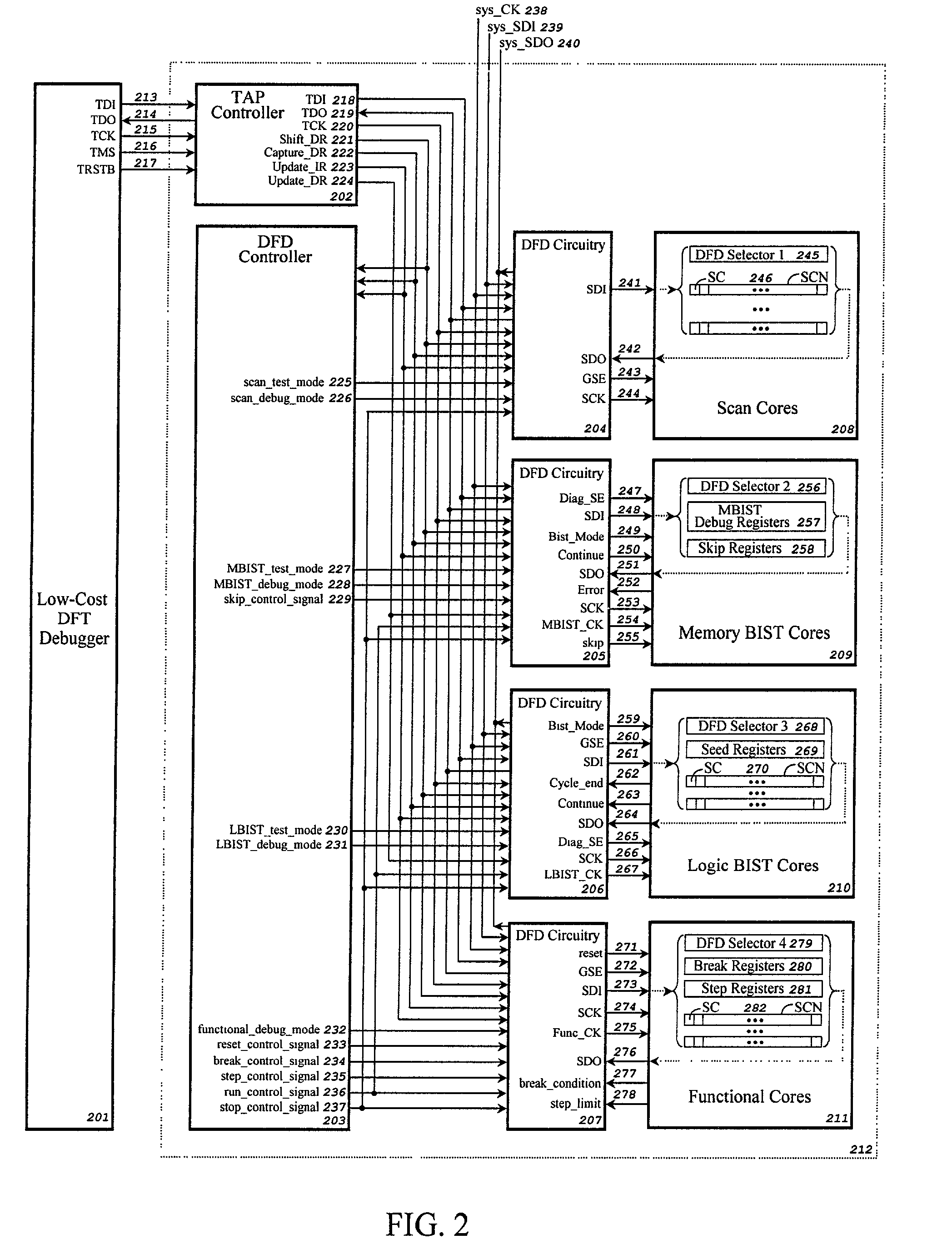Method and apparatus for diagnosing failures in an integrated circuit using design-for-debug (DFD) techniques
- Summary
- Abstract
- Description
- Claims
- Application Information
AI Technical Summary
Benefits of technology
Problems solved by technology
Method used
Image
Examples
first embodiment
[0090]FIG. 4 shows a scan connector 408 of the present invention to stitch multiple scan chains SCN 409 to 412 to one serial scan chain SSC 414 for the purpose of diagnosing scan cores 208, logic BIST cores 210, or functional cores 211.
[0091]The scan chain SCN 409 is driven by the scan clock SCK[1]416, the scan chains SCN 410 and 411 are in the same clock domain driven by the scan clock SCK[2]419, and the scan chain SCN 412 is driven by the scan clock SCK[3]424. With four multiplexers 402 to 406 in the scan connector 408, the four scan chains 409 to 412 are stitched into one serial scan chain SSC 414. The Select5426 signal should be generated so that all scan chains SCN 409 to 412 get input data from TDI 218 in debug mode and from the external scan data inputs sys_SDI[1]415, sys_SDI[2]418, sys_SDI[3]421, and sys_SDI[4]423 in test mode. The Select4435 signal should be generated so that the boundary-scan chain BSC 401, the serial scan chain SSC 414, or other registers can be properly ...
second embodiment
[0093]FIG. 5 shows a scan connector of the present invention to stitch multiple scan chains to one serial scan chain for diagnosing scan cores 208, logic BIST cores 210, or functional cores 211.
[0094]In FIG. 5(a), the serial scan chain SSC 501, formed in the way shown in FIG. 4, is placed before the boundary-scan chain BSC 502. The Select6503 and Select7504 signals should be generated so that the boundary-scan chain BSC 502, the combined scan chain composed of the serial scan chain SSC 501 and the boundary-scan chain BSC 502, or other registers can be properly placed between TDI 218 and TDO 219 according to various test and debug requirements.
[0095]In FIG. 5(b), the serial scan chain SSC 506, formed in the way shown in FIG. 4, is placed after the boundary-scan chain BSC 505. The Select8507 signal should be generated so that the boundary-scan chain BSC 505, the combined scan chain composed of the boundary-scan chain BSC 505 and the serial scan chain SSC 506, or other registers can be...
third embodiment
[0096]FIG. 6 shows a scan connector 606 of the present invention to stitch multiple scan chains SCN 607 to 610 to a plurality of grouped scan chains GSC 612 for diagnosing scan cores 208, logic BIST cores 210, or functional cores 211.
[0097]The scan chain SCN 607 is driven by the scan clock SCK[1]614, the scan chains SCN 608 and 609 are in the same clock domain driven by the scan clock SCK[2]617, and the scan chain SCN 610 is driven by the scan clock SCK[3]622. With four multiplexers 602 to 605 in the scan connector 606, the four scan chains SCN 607 to 610 are stitched into three groups: the scan chain SCN 607 being in the first group, the scan chains SCN 608 and 609 being in the second group, and the scan chain SCN 610 being in the third group. The Select9624 signal should be generated so that all scan chains SCN 607 to 610 get input data from TDI 218 in debug mode and from the external scan data inputs sys_SDI[1]613, sys_SDI[2]616, sys_SDI[3]619, and sys_SDI[4]621 in test mode. The...
PUM
 Login to View More
Login to View More Abstract
Description
Claims
Application Information
 Login to View More
Login to View More - R&D
- Intellectual Property
- Life Sciences
- Materials
- Tech Scout
- Unparalleled Data Quality
- Higher Quality Content
- 60% Fewer Hallucinations
Browse by: Latest US Patents, China's latest patents, Technical Efficacy Thesaurus, Application Domain, Technology Topic, Popular Technical Reports.
© 2025 PatSnap. All rights reserved.Legal|Privacy policy|Modern Slavery Act Transparency Statement|Sitemap|About US| Contact US: help@patsnap.com



